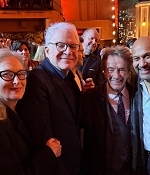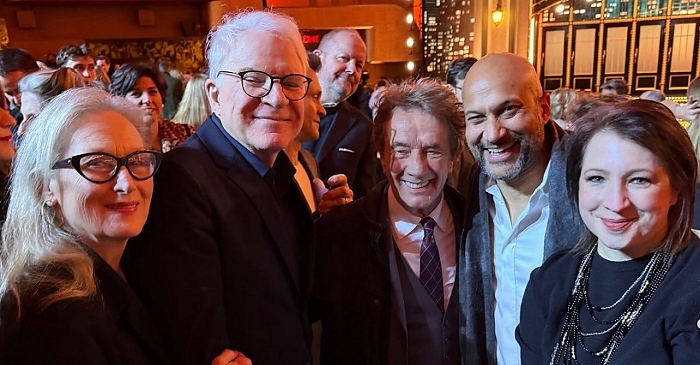|
Simply Streep is your premiere source on Meryl Streep's work on film, television and in the theatre - a career that has won her the praise to be one of the world's greatest working actresses. Created in 1999, we have built an extensive collection to discover Miss Streep's body of work through articles, photos and videos. Enjoy your stay.
|
Celebrating
25 years
of SimplyStreep
|
|
Streep Savvy
The Philadelphia Inquirer ·
September 17, 1998
· Written by Steven Rea
|
Meryl Streep took her mother to see One True Thing the other day. They sat in the screening room, watching as the hard-charging journalist daughter (Renee Zellweger) comes home to care for her cancer-stricken mother (you know who) while college professor dad (William Hurt) stands on the periphery, lost in a world of old books and young coeds. “It really upset her,” says Streep, with a laugh. “But not for the right reasons. It upset her that I died, and she sort of couldn’t get over that.” As in Meryl, her little girl, died, not the character the two-time Oscar-winner was playing up there on the screen.
Streep, holding court, and a cup of coffee, in the Essex House on a recent sunny morning, isn’t sure about letting her three girls see One True Thing – smartly adapted from the Anna Quindlen novel by director Carl Franklin, and opening everywhere tomorrow. “It’s hard for them to separate in that way,” she explains. “My girls are 15 and 12 and 7, and they’d be so upset. They were upset when I fell down the stairs in Death Becomes Her even though they knew it was a dummy. They were there on the set when I shot it, and they saw them throw the dummy down the steps 20 times and they went to the movies and burst into tears. And it was supposed to be a funny thing!” Most people who go to see One True Thing – a carton-of-Kleenex family drama likely to win Streep her 11th Academy Award nomination – won’t have the same problem. As she has in the best of her film portrayals, from Sophie in Sophie’s Choice to Karen Silkwood in Silkwood to Lindy “the dingo ate my baby” Chamberlain in A Cry in the Dark, Streep loses herself, or finds herself, in the role. “It’s one of those times when Meryl Streep gets to hit it out of the park,” says her onscreen offspring, Zellweger.
The film, which is full of turmoil, tears, and the thorny dynamics of parents and children, represents a homecoming for Streep. Literally. “We were shooting in my hometown, virtually where I grew up,” says the native of suburban Madison, N.J. “I had my first date in high school at the movie theater around the corner from the house where we were shooting. It was really local: I didn’t have to strive for the accent or anything, because it comes with. It was a world I know well, and, in a way, a world that still exists.” Just barely, however. Though the former New York Times columnist’s autobiographical novel takes place in the ’80s, the actress, who is 49, thought the film should be done as a ’70s period-piece to make the chasm between the stay-at-home, ladies’ luncheon matriarch and the careerist daughter more credible.
“Anna Quindlen and I were talking on the phone,” she explains, “and I said I just don’t know why they’re not making this a period movie . . . because it really is about the confrontation between these two generations of women. [Between] my mother’s generation and Anna’s mother’s generation – because Anna and I are the exact same age – and their expectations for their life and the arena in which they would do their work, and their daughters and what they raised them to expect and look for and hope for and dream of. . . . I had read it so clearly to be me and my mother and Anna and her mother. . . . “We moved it [the time frame] just to the very edge of where you would believe that this lady – me – missed the ’60s. So, if she’s married in ’63 and had a kid right away, then you would believe that she felt like her daughter was an alien creature.” Still, no matter what the decade, there’s always going to be a divide between mother and daughter, a gulf of misunderstanding and an epic taking-for-grantedness on the part of the child. The movie, says Streep, “has applications for mothers and daughters now, for me and my daughters, for how to get them to live their life right here and right now. To be in the room with your happiness, where it exists, because it’s here if you choose to recognize it’s here, and if you don’t, it’s not.” Streep has played mothers before, of course: the young Polish Jew, Sophie, faced with her profound dilemma; the Aussie Lindy Chamberlain; the divorcee Joanna Kramer in Kramer vs. Kramer; the stalked whitewater rafter of The River Wild. But dotty, resilient Kate Gulden, Streep’s One True Thing character, is grounded in a more familiar sort of universe.
“I just wanted to play somebody who wrangled life in the way that I do and my mother does,” she says, explaining her keen interest in tackling the project. “Somebody with some attachment to what is commonly understood as contemporary reality.” The actress’ own contemporary reality is very much about family. With her husband of 20 years, sculptor Donald Gummer, Streep is an active, involved parent. She schedules her film work around her children – Henry, 18, and daughters Mary Willa, Grace and Louisa – and their school life. She has pretty much abandoned the theater, a world in which she shone after graduating from Yale Drama School in 1975, because it would mean not being there when her girls arrived home from school. The Gummer-Streeps live in the northwest corner of Connecticut, at the foot of the Berkshires. When she was making Dancing at Lughnasa in Ireland last summer, she took the family with her. When she was making One True Thing in New Jersey last fall, she had a helicopter fly her home at the end of the day.
“I’m home most of the time, because I really do one picture a year,” she says. “This year I did two in a row, but that’s because the year before I didn’t do anything. . . . But I’m home more than not, and that’s much harder work. “It’s a different kind of focus and sensibility. You have to be like a waitress. You have to remember all the tables and what they want and in what order. When you’re working it’s a very luxurious kind of focus – I’m only going to pay attention to this and that, and shape this moment – and all the periphery is forgotten. “In mothering, the periphery rules. In fact, the periphery is where you get all your information. The two require different skills, but I’m glad I was a waitress for so long. And I don’t mean waitress simply because I’m waiting on tables – which I am – but in terms of the concentration you need to do that job well . . . handling the temperament in the kitchen, which is always huge.”
According to those who have worked with her, Streep isn’t the sort of actress who takes her work – or her characters – home with her. “One would think, because of the depth of her performances, that it would require her to be in character all the time,” says One True Thing director Franklin. “You know, some real strong method that she would be operating from that would preclude probably her family and everything else, and that’s just not so. She very easily gets into character and she likes to get it quick. . . . She has a very easy, almost irreverent way of working, which is, I think, wonderful. She’s not precious at all.” That’s a sentiment shared by Pat O’Connor, the Irishman who directed Streep in the adaptation of Brian Friel’s play, Dancing at Lughnasa – due in art houses in November, and more than likely to garner the actress her 12th Academy Award nomination. (Yes, it could well be Streep vs. Streep come Oscar-time.) “I wouldn’t say there were too many Americans I would have wanted in the film, because it’s such an Irish piece, it’s set in 1936, it’s very rural, there’s no glamour in it,” explains O’Connor of his film, about five sisters abandoned by the men in their lives and the townfolk around them. Streep, as the eldest sister, Kate, is a joyless spinster, a stern schoolteacher lost in regret and quiet rage.
“The worst thing to get is an American actress who’s famous for glamour and get her to try to play real and homey, but Meryl Streep is just a great actress by any standards, in any language and with any accent, so that’s not a problem,” the director says. “She was very well-prepared. She was totally committed, with a very astute intelligence. When she arrived, she was the first into the rehearsal reading room, even though she had flown the Atlantic the night before. I was prepared for the fact that she might be in a couple of hours later . . . and right through the film there was nothing but a really top-class actor working with other actors. She’s very respectful of people who are committed to their work and who aren’t phonily vain. She’s a very rooted person, she’s very real. And brilliant.”









